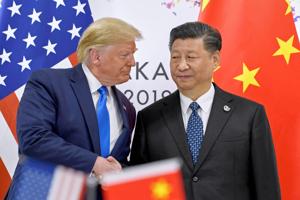President Donald Trump announced on Friday his intention to impose a 100% tariff on Chinese imports starting on November 1, 2025, or sooner, escalating tensions between the United States and China. This announcement follows China’s recent restrictions on exports of rare earth elements, crucial materials for various technologies, prompting concerns about a renewed trade war that could negatively impact the global economy.
In a post on his social media platform, Truth Social, Trump stated, “Starting November 1st, 2025 (or sooner, depending on any further actions or changes taken by China), the United States of America will impose a Tariff of 100% on China, over and above any Tariff that they are currently paying.” This potential increase in tariffs could raise the total tax on Chinese goods to levels that had previously alarmed financial markets, with analysts warning of a possible global economic downturn.
The president’s comments came after a tumultuous week in which financial markets reacted negatively to growing trade tensions. The S&P 500 index fell by 2.7%, marking its worst day since April, when earlier tariff threats were made. Trump’s announcement risks reigniting the trade war initiated during his administration, which had already imposed tariffs up to 145% on Chinese goods.
The trade conflict intensified following China’s announcement of new export controls on rare earth elements, which require special approval for foreign companies to ship these materials abroad. These elements are essential for manufacturing technologies such as computer chips and military equipment. In response, Trump accused China of becoming “very hostile” and holding the world “captive” by restricting access to these vital resources.
While Trump did not formally cancel a planned meeting with Chinese President Xi Jinping at the upcoming Asia-Pacific Economic Cooperation (APEC) summit in South Korea, he suggested that there may be no reason to meet given the current circumstances. The meeting was intended to address ongoing trade issues and foster discussions on bilateral relations.
The new tariffs and China’s restrictions are part of a broader pattern of tensions between the two nations, which have struggled to reach a sustainable compromise since the initial trade war began. Both sides previously agreed to reduce tariffs during negotiations in Switzerland and the United Kingdom, yet significant barriers remain, particularly regarding access to rare earths and advanced technologies.
Sun Yun, director of the China program at the Stimson Center, commented on the recent developments, stating that Beijing’s response appears disproportionate but may allow for de-escalation. “There is room for maneuver, especially on the implementation,” she noted, highlighting the complexities of the ongoing negotiations.
The U.S. government is also considering its own export controls on critical software from American firms in retaliation to China’s actions. Analysts highlight that the high stakes surrounding these tariffs could create lasting impacts on the fragile U.S. job market and inflation rates, especially as concerns grow over potential layoffs due to government shutdowns.
The European Union Chamber of Commerce in China warned that these developments could complicate the global supply chain for rare earth elements, which are integral to a variety of industries ranging from electronics to defense. Gracelin Baskaran, director of the Critical Minerals Security Program at the Center for Strategic and International Studies, emphasized that China’s dominance in the rare earth market gives it significant leverage in these negotiations.
As both nations continue to exchange tariffs and restrictions, the possibility of a renewed trade war looms large, with significant implications for global economic stability. The unfolding situation will require careful monitoring as both the U.S. and China navigate these complex trade relations.
